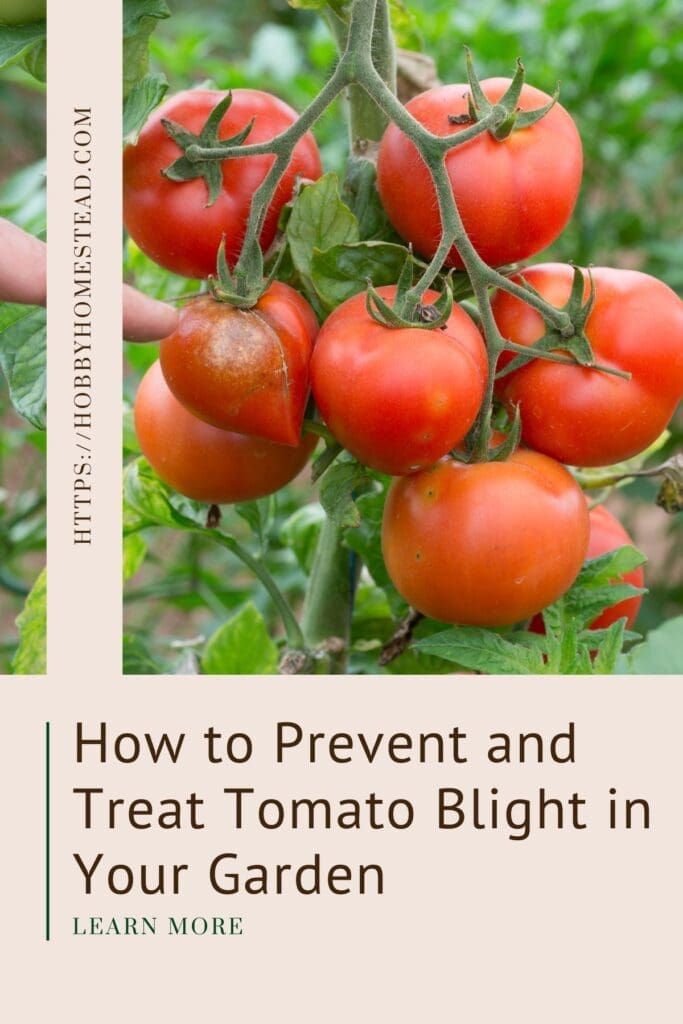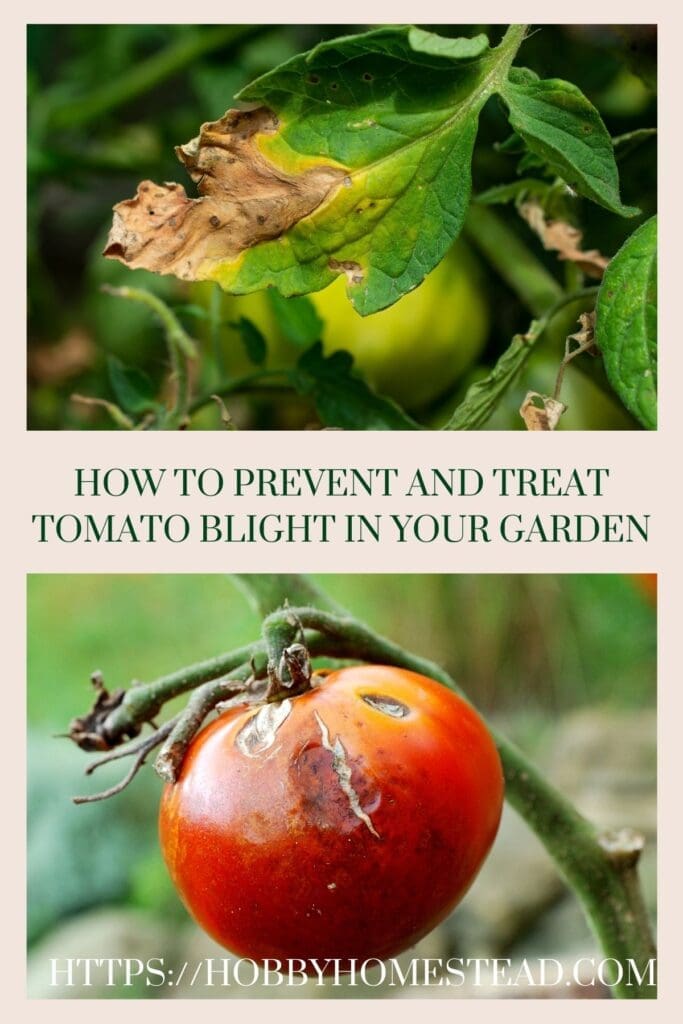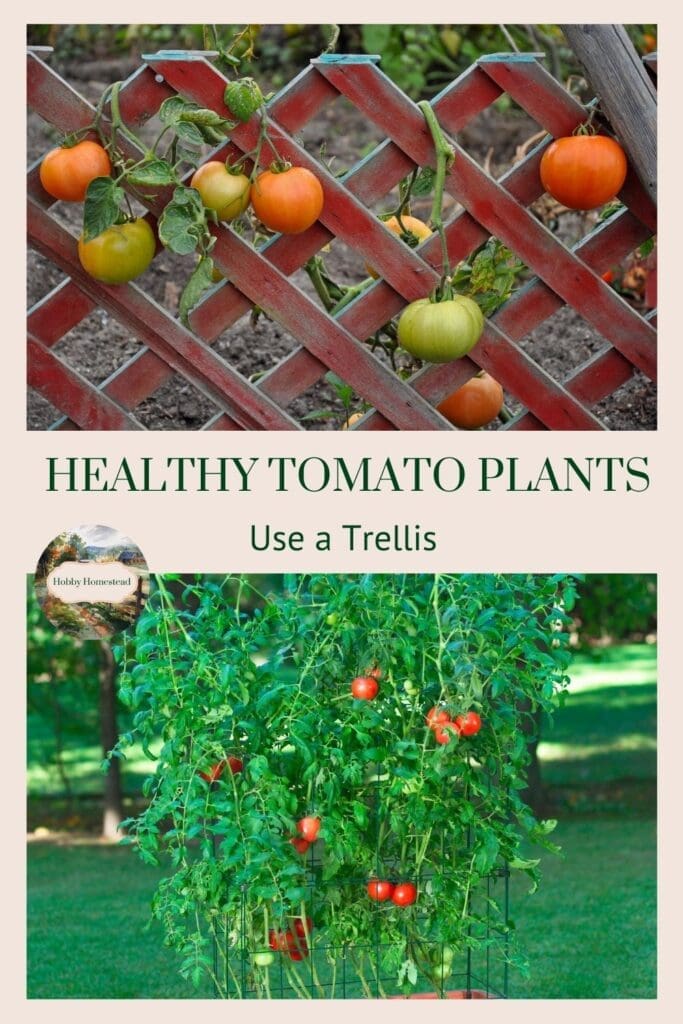Learn how to prevent and treat tomato blight. It’s one of the most devastating diseases home gardeners face during the growing season. It can affect your tomato plants, entire tomato crop, and even spread to potato plants. Understanding the different types of blight and how to prevent and treat them is essential to maintaining healthy plants and a productive garden.
About ten years ago, we had a gorgeous crop of tomatoes we were looking forward to eating and canning. The plants were loaded with fruit. About one month before they would be ready for harvest, our plants were devastated by blight. We lost all of them. So frustrating.
Since then, we’ve done our homework on prevention. We tried a few things to stop the blight at the time, but nothing we tried worked.
Here’s what we have found out since our frustrating year.

What is Tomato Blight?
If you’ve never heard of tomato blight, it refers to a group of fungal diseases that primarily affect tomato plants and potato crops. The two main forms are early blight, caused by Alternaria solani and Alternaria tomatophila, and late blight, caused by Phytophthora infestans. Both diseases can wreak havoc on your plants, causing brown spots, defoliation, and in severe cases, the loss of your entire crop.
Did you know? Late blight was infamous for causing the Irish potato famine in the 19th century, but it can also destroy tomato plants in a single season if not managed properly.
What are the best ways to prevent blight?
In short, rotate crops, remove plant debris, water at the base, and space your plants properly for good air circulation. You can also plant resistant varieties to reduce the risk of infection.
Identification and Symptoms
Early blight usually begins on the older leaves of the plant, causing brown spots with concentric rings that resemble a target. As the disease progresses, it moves upward, eventually affecting the entire plant.
You may also see brown lesions on the tomato fruits. This type of blight thrives in wet conditions, especially during periods of humid conditions and extended periods of wet weather.
Late blight, on the other hand, is more aggressive. It creates dark, water-soaked spots on leaves that quickly enlarge, killing the plant.
The disease can affect the leaf tissue, leaf stalks, and even the tomato fruits. Late blight infections often occur during periods of high humidity and cool, wet weather.
Preventing Blight in Tomatoes
Prevention is key when it comes to blight. Here are some simple ways to reduce the risk of infection.
Practice crop rotation. Avoid planting tomatoes or any plants in the Solanaceae family (like potatoes) in the same spot year after year.
Remove plant debris. At the end of the season, clear out all plant material to eliminate hiding spots for fungal spores.
Space plants. Ensure your tomato plants have enough room for good air circulation. This helps reduce the buildup of moisture and prevents the growth of fungal disease.
Water properly. Use drip irrigation or a soaker hose to avoid wetting the leaves. Watering at the base of the plant can prevent wet conditions that promote blight.
Mulch. Adding mulch to the base of the plant helps reduce splash-back of soil-borne pathogens onto the lower leaves.
By following these cultural practices, you can significantly reduce the risk of blight in your garden.
Controlling Early Blight
The best way to control early tomato blight is through proper cultural practices and tomato blight treatment. Start by removing any infected plant material from your garden. Practice crop rotation. Avoid planting tomatoes in the same spot next year. It will disrupt the cycle of early blight spores.
Proper watering techniques are also important. Using drip irrigation or a soaker hose will keep water off the leaves, preventing the spread of fungal spores.
Avoid overhead watering and make sure your plants have enough space for good air circulation to reduce humidity levels around the base of the plant.

Controlling Late Blight
Late blight requires immediate action because of how quickly it can destroy your entire crop. Remove and destroy any diseased plants as soon as you notice symptoms.
Cornell University recommends applying protectant fungicides, such as copper sprays, as a preventive measure. Always follow the instructions for mixing, typically 2 tablespoons of fungicide in a gallon of water.
Planting resistant varieties of tomatoes is also a great way to prevent late blight. Some resistant tomatoes are specially bred to combat late tomato blight, providing disease resistance to keep your garden thriving.
Plant Blight Resistant Tomato Plants
Planting resistant or disease-tolerant varieties is one of the most effective ways to manage both early blight and late blight. For early blight, consider growing varieties like ‘Mountain Magic,’ ‘Celebrity,’ ‘Juliet,’ or ‘Rutgers,’ which can tolerate the disease.
To protect against late blight, choose resistant cultivars such as ‘Mountain Gem,’ ‘Plum Regal,’ ‘Mountain Magic,’ or ‘Red Pear.’ These varieties offer an extra layer of protection, helping to ensure a healthier, more resilient tomato crop.
How do I know if my tomato plant has blight?
Look for brown spots on the lower leaves that spread upwards, or water-soaked lesions on the leaves and fruits. These are classic signs of blight.
Can I compost infected plants?
It’s generally not recommended to compost infected leaves or plants with blight because the fungal spores can survive and infect your garden next year.
It’s best not to compost any blight-infected parts of the plant in your home compost pile, as the fungal spores from the blight can survive and potentially spread when you use the compost in the future. Instead, dispose of infected leaves and plant debris by bagging them and removing them from your garden area, or burn them if local regulations allow. This helps prevent the blight from returning the following year and protects future crops.
Can a tomato plant recover from blight?
While it’s nearly impossible to fully eliminate blight once it infects a tomato plant, careful management and timely treatment can help slow its progression. With diligent care, your plant may still produce some fruit despite the infection.
Does Epsom salt prevent tomato blight?
No, Epsom salt does not prevent blight. In fact, using Epsom salt may worsen the situation by increasing magnesium levels in the soil, which can block the plant’s uptake of calcium. It’s best to avoid adding Epsom salt when planting tomatoes.
Are there chemical controls for blight?
Yes, chemical controls such as protectant fungicides and copper sprays can be used. Be sure to apply them before wet weather or during favorable conditions for blight.

Can water and soap be applied for stopping blight?
Soap and water are not effective for controlling tomato blight. While they can be useful for removing pests like aphids, they do not address fungal diseases such as early blight or late blight. Blight is caused by fungal spores, which are best managed with protectant fungicides, good cultural practices, and proper garden hygiene. Washing leaves with soap and water may not prevent the spread of fungal spores and could potentially harm the plant’s foliage.
Does blight affect potato crops too?
Yes, both tomato plants and potato tubers are susceptible to blight, as they belong to the same Solanaceae family.
By understanding the causes and symptoms of blight, as well as taking preventive measures, you can protect your tomato plants and enjoy a bountiful harvest during the growing season.
Reference
Cornell University. Managing Tomato Diseases Successfully.


